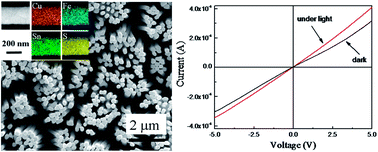Preparation and photoelectric property of a Cu2FeSnS4 nanowire array
Abstract
A single crystalline Cu2FeSnS4 nanowires array has been prepared via a convenient solution approach. Porous anodic aluminum oxide was used as a morphology directing template and played a significant role in the formation of single crystalline Cu2FeSnS4 nanowires. The as-prepared Cu2FeSnS4 nanowires are uniform with a [110] growth direction. Structure, morphology, composition and optical absorption properties of the as-prepared samples were characterized with X-ray powder diffraction, transmission electron microscopy, energy dispersive X-ray spectrometry, scanning electron microscopy and UV-Vis spectrophotometry. The formation mechanism of Cu2FeSnS4 nanowires array has been discussed. Thin films prepared from Cu2FeSnS4 single crystalline nanowires displayed an obvious photoelectric response, suggesting their potential application as low cost solar absorber materials.


 Please wait while we load your content...
Please wait while we load your content...